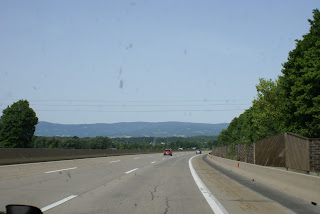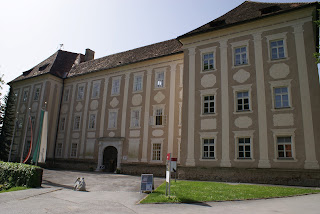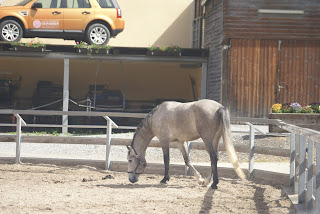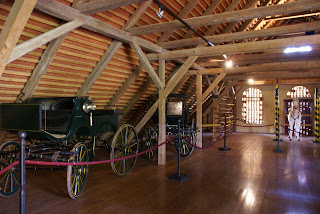On Sunday, Daniela and her daughter Theresa and I went to Piber to visit the Lipizzaner stud farm.
The drive was nice. The pictures don't quite capture the view of the hills in the distance.
We know we're on the right track when we start seeing horse signs.
Random tower on a hill.
This is the Hundertwasserkirche in Bärnbach. We drove past it on the way in and stopped to take a closer look on the way back. Unfortunately, by then my camera battery had died because I hadn't paid enough attention to it before we left, so I don't have as many pictures of it as I normally would. Daniela took some pictures of it with her iPhone and I'll upload those when we get them transfered. The building was designed by Friedensreich Regentag Dunkelbunt Hundertwasser, whose chosen name means something along the lines of Peaceland Rainyday DarklyColorful Hundredwater. I think it fits. Anyway, he's a rather well known artist who also works in architecture. The facade is covered in multiple mosaics. The interior is more mundane. There's a path around the church with a bunch of different archways with symbols representing everything from animist beliefs in Africa to Shinto to Islam.
Here's another view of the church as we drove by.
We arrived!
This flying horse statue hung over a pond on our way up the hill to the entrance. Have I mentioned this country has a lot of hills? Daniela is now on my long list of people who think I have asthma.
This is the palace at the top of the hill. Now it seems to house administrative offices. It has a pretty courtyard.
We arrived just in time to join a tour. Here's our tour guide. She explained that between the horses at Piber and some of their satellite farms, they have about 250 horses.
Here's a roly poly mortgage down payment.
This handsome fellow was hanging out in a paddock between the stallion and mare barn and the mares with foals barn.
This is the church on the property.
Here we are visiting the barn where the mares stay with their foals. The guide explain that they use a special blend of straw to keep the ground as dry as possible.
The foals are born brown, then as they age they'll turn gray or dapple gray, and in adulthood they'll lighten. A small percentage stays black in adulthood. A black horse is kept at Piber as a tradition as a symbol of good luck.
The tour guide explained that Lipizzaners take a long time to mature. Real training doesn't begin until they're four or so.
After the foal barn, we went to the blacksmith area where this fellow taught us about horseshoes.
Here they show the different sizes and types of horseshoe. Lipizzaner feet aren't very big, actually.
Then he showed us how to make a horseshoe by hand. Here he's holding a flat piece of iron.
Then he heated the iron and began to shape it into a shoe.
He said that the apprenticeship to become a smith at Piber lasts three years. No mention of whether being good looking was a requirement for the job.
After that we visited the broodmare barn. Each stall has a name plaque above it. This gives the name of the mare and her birth-order number, her date of birth, and the names of the sire and dam.
It was hard to get a good photograph of the horses in their stalls since the bars were close together. The stalls were well supplied with sawdust.
After the mares, we visited the stallions. Here's the black horse that must stay in residence.
Here's the plaque for Neopolitano Nima I, born in 1979 (!!!). After a stallion retires, they return to Piber to live out the rest of their natural lives.
You may notice a theme with the names. The first part of the name comes from the breeding line. There are six different stallion lines and they take care to avoid inbreeding as much as possible.
They also have carriages. If I understood the tour guide, they usually use mares for the carriages. All the mares used in the breeding program must be trained as well. Only the stallions go to the Spanish Riding School in Vienna, but a mare must also be talented in order to be selected as a broodmare candidate.
Here is unfortunately where my camera batteries ran out. I have more pictures, but I have to get them off Daniela's phone.





























































Sounds like the blacksmith was very interesting...
ReplyDelete